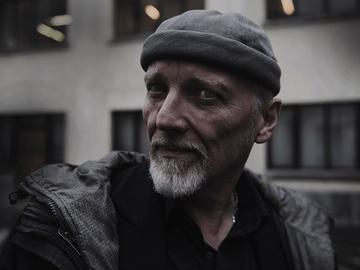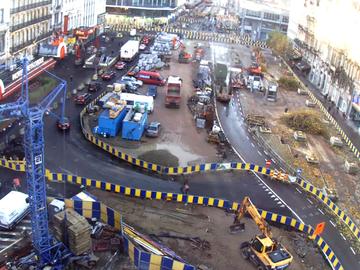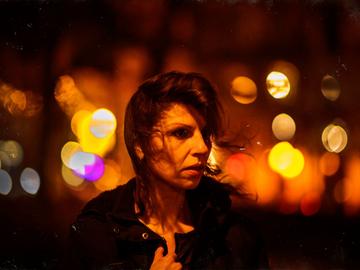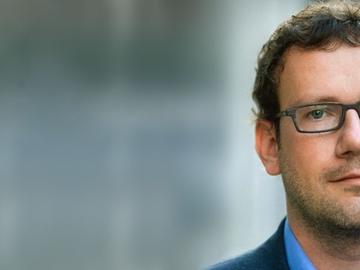We don’t want to impute visionary powers to him, but still... Max Pinckers’s disruptive take on documentary photography piloted the world into the post-truth era long before Donald Trump had tweeted his first 'Sad!' And he did it without a Trophy Camera. In Margins of Excess, the deus ex Magnum delves deeper into the United States of Excess.
© Heleen Rodiers
| Max Pinckers: 'What I try to do is not to sow confusion or make you doubt whether there is really a truth – because I assure you, there is.'
Anno Donaldi 1. The first year of the reign of the Donald, the beginning of the post-truth era. In July 2016, when Max Pinckers began working on his new project Margins of Excess, he could not have dreamed of more tenacious grips on reality, beleaguered as it is by fake news, real fiction, lies, and half-truths. But the land of excess gave him a helping hand and moulded the zeitgeist to his work.
The Brussels-based photographer has been exploring the intersection of reality and fiction for many years, with a unique, disruptive take on documentary photography. He counters the inherent idea of truth and truthfulness and the genre’s urge for aesthetics by staging, manipulating, and over-aestheticizing his pictures, and thus making his viewers conscious of how they see.
With Max Pinckers, what you see is never what you get. His photographic practice doesn’t stop with the image. On the contrary, it stretches far beyond the frame, articulating a considered, multi-layered reflection on images, perception, the role of the photographer, and the ritual of looking. “Our reality or our perception of it is complex,” Max Pinckers says.
“It is a constant switching between the real and the unreal, certainties and doubt, the tangible and the emotional. The dangerous thing about Donald Trump is that he abuses this confusion for ideological ends, to the point at which people simply no longer know what is true. What I try to do is not to sow confusion or make you doubt whether there is really a truth – because I assure you, there is. Rather, I try to reflect on how images direct our perception of that truth. How are they used to push ideological agendas? What are the roles that conventions and beliefs play when it comes to images?”
Believing is seeing
In 2017, this led Max Pinckers to North Korea for The New Yorker, to the spot in Spain where Magnum founder Robert Capa photographed his Falling Soldier in 1936, and with heart and soul to Recyclart for the Fusée de la Motographie, the sympathetic itinerary museum which collected the rich photography scene in Brussels and Belgium around some magic boxes – next stop: 11 January at the Hangar Art Center.
But for the majority of 2017, Max Pinckers and his wife/assistant/researcher Victoria Gonzalez-Figueras were working on the project for which he will soon be publishing what will undoubtedly be one of the top (photo) books of the year. Margins of Excess presents six people – Max Pinckers tellingly calls them “characters” and “protagonists” – that have appeared in the American media with stories that challenge “objective journalistic media patterns”.
These people include private detective Jay J. Armes, who has constructed a whole world around his James Bond-like persona, or Darius McCollum, who compulsively high-jacked trains only to be able to drive them. There is also Herman Rosenblat, who invented a love-story set in a concentration camp during WWII, or Richard Heene, whose son purportedly hid in a homemade helium balloon and thus triggered an outbreak of hysteria on live television, or Rachel Doležal, who pretended that she was “black”, and Ali Alqaisi, who pretended to be the “hooded man” in the iconic photo from Abu Ghraib prison.
“We intentionally chose cases that directly confront objective journalism with a certain subjectivity. The subjective realities of these characters function a little bit like a photo. It is difficult to comprehend how it relates to the truth and reality. Belief also plays a role; the fact that we ultimately see the things that we want to see in images. Images rarely change our minds. People always go for the better story. However much evidence you show somebody, if they believe something, it is difficult to convince them otherwise.”
Images rarely change our minds. People always go for the better story.
Lost in a dream
Margins of Excess is about the role of the media, especially in the American landscape, and the way we as citizens acquire our information. It is about how certain characters end up in the media that journalism doesn’t really have the capacity to understand or communicate about because their stories are not so straightforward. Characters that are stuck, literally, in the margins of excess – the unintended content of a photograph, due to the inability of the lens to discriminate.
Max Pinckers stretches this ambiguity, which is initially related to the personal stories of the six characters, into a panorama that features headlines, press articles, interviews he has done, portraits, and an associative cluster of images. “We interlace the factual elements with all kinds of photos that we took along the way and which I imaginatively associate with their stories. That’s where things get interesting for me, because the stories of the six characters start referring to something else.”
Because it is not really about Rachel Doležal or Darius McCollum, their conflict, and their rise and fall, but about identity and perception. “All of the photos and texts are peppered with motifs like apparitions, weeping Marys, UFOs, or threatening white vans. Or with staged pictures of people mourning; photos that we took with actors in New York and in Los Angeles. These sorts of images have become conventional in photo journalism. They are pictures that we see over and over again after something has happened, because they are powerful and moving pictures with which readers immediately identify.
All these little associations that we touch on are a tangible illustration of how someone thinks, makes mental connections, zaps around, and can suddenly be moved and get lost in a story. Most of the characters do play with a kind of fantasy that is like a reality to them. We will never grasp complete truth. Is it all a game or are they sincere? It is relatively clear to me that they never intended to tell barefaced lies."
"I think there was always a more profound personal motivation. It is difficult for me to have anything other than genuine and deep compassion for them. It is stronger even: I look up to them. I think it is fantastic that you can get lost so deeply in your fantasy and nevertheless be so confident and convinced about it."
"But of course this conflicts with the ‘objective’ model in the media. Just look at Ali Alqaisi. We know that he is not the hooded man from Abu Ghraib. But he did go through exactly the same experiences. So does it matter whether the photo is actually of him? I think that is a very interesting question.”
The secret life of photos
“A thing need not be real to be true,” British author Jeanette Winterson once said in an interview. This is the whetstone on which all incisive fiction is sharpened, and Max Pinckers uses it for his playful and highly stimulating exploration of the boundaries of the genre of documentary photography. He brings it closer to real life and charges it with a human touch, compassion, poetry, and an acute sense of stories and registers.
The way he does so in his photo books was not only rewarded with admiring reviews from Magnum greats like Martin Parr and Alec Soth, but in 2015 also caused him to be selected to be a candidate member of the world-famous photography agency. Until the middle of 2017, when he didn’t get the votes needed to proceed to the next stage of Magnum membership.
“Many photo journalists try to get into Magnum. And that is understandable because it gives you an enormous amount of exposure. But it was never really my ambition. The voting system means that it involves a lot of politics, and you know it will be very difficult in an association that is divided 50/50 between progressive and traditional thinkers. I don’t feel as though I have lost anything though. I always thought of it as an experiment. How far can I go?"
"I was interested to find out how such a membership would change perceptions of my work. Whenever one of my staged photographs was exhibited in the context of Magnum, people much more quickly assumed that it was a genuine observation, while the same picture in an exhibition with some of my other works might be interpreted very differently. In that sort of context, I had more freedom to do something crazy.”
One of the “crazy things” that Max Pinckers has been doing over the past year, along with Dries Depoorter, is the development of an AI-powered camera that only makes award-winning photos. “The Trophy Camera is a prototype that uses a database of World Press Photo Award-winners, so it contains about fifty pictures. We want to develop a camera where you don’t have to press the button to take a photo anymore, but can just scan your environment and the camera decides what will make a good photo."
"But to train the AI, you need a dataset with at least one million images. There is not a single press agency that will give us one million pictures for free to develop an algorithm that will then take away their jobs.”
How do you look at photography when what you are doing might lead to the disappearance of the traditional photographer? “That’s a difficult question,” Max Pinckers admits. “To me, photography has a lot to do with stories. It is the struggle with aesthetics, especially in the context of documentary photography. But also with a kind of…subconsciousness or poetry."
"I know it sounds like a cliché, but I believe that pictures can have their own life, their own will. They are things that exist and can respond to you. They can teach you things about yourself that you didn’t know. You could call it a ritual or a strange sort of superstition.”
This is photography that pays tribute to the margins of excess, the places where life filters through, where stories are told, and where compassion pushes the button on your camera. Not a bad resolution for 2018.
Who is Max?
Max Pinckers was born in Brussels in 1988, and studied at the Royal Academy of Fine Arts (KASK) in Ghent, where he currently conducts doctoral research in the Arts on the conventions of classical photo journalism.
He has been hailed by masters like Martin Parr and Alec Soth for excellent self-published photobooks such as Lotus (2011), The Fourth Wall, (2012) and Will They Sing Like Raindrops or Leave Me Thirsty (2014), in which he weaves an appealing and multi-layered web between reality and fiction.
Between 2015 and the summer of 2017, he was nominated to be a member of the photo agency Magnum. His new book Margins of Excess will be published in 2018.
> Margins of Excess. Self-published, 354 p., €50
> Solo show: It is difficult/To get the news from poems. 25/1 > 18/8, Gallery Sofie Van de Velde,
Antwerp
Read more about: Brussel , Expo , Kijk op 2017 , Max Pinckers




Fijn dat je wil reageren. Wie reageert, gaat akkoord met onze huisregels. Hoe reageren via Disqus? Een woordje uitleg.